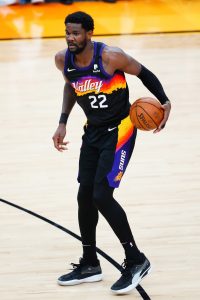As Larry Coon explains in his invaluable CBA FAQ, the term “base year compensation” technically no longer shows up in the NBA’s Collective Bargaining Agreement, and hasn’t since 2011. A relic of past agreements, the base year compensation rule was intended to prevent teams from signing free agents to new contracts that were specifically intended to facilitate salary-matching in trades.
While the base year compensation rules have mostly been adjusted and/or removed from the CBA in recent years, there’s still one situation where they apply. Teams have to take them into account when completing sign-and-trade deals.
The BYC rules apply to a player who meets all of the following criteria in a sign-and-trade:
- He is a Bird or Early Bird free agent.
- His new salary is worth more than the minimum.
- He receives a raise greater than 20%.
- His team is at or above the cap immediately after the signing.
If the player meets those criteria and is included in a sign-and-trade deal, his outgoing salary for matching purposes is considered to be his previous salary or 50% of his new salary, whichever is greater. For the team he is being signed-and-traded to, his incoming figure for matching purposes is his full new salary.
 Here are a couple specific examples to help make things a little clearer:
Here are a couple specific examples to help make things a little clearer:
Let’s say the Suns want to sign-and-trade Deandre Ayton this offseason. He’s a Bird free agent, his new salary will be well above the minimum, and the Suns project to be an over-the-cap team. Having made $12,632,950 in 2018/19, Ayton figures to receive a raise significantly higher than 20% — if he signs a maximum salary contract, it’s projected to start at $30,500,000. So he meets the BYC criteria.
In a scenario where he signs a max deal as part of a sign-and-trade, Ayton’s salary for matching purposes from the Suns’ perspective would be $15,250,000, which is 50% of his new salary (that amount is greater than his previous salary). From his new team’s perspective, Ayton’s incoming figure would be his actual salary, $30,500,000.
Zach LaVine is another top free agent who would meet the BYC criteria if he’s signed-and-traded by the Bulls this offseason. If he gets a maximum salary contract – projected to be worth $36,600,000 for a player with his NBA experience – his outgoing salary for matching purposes would be $19,500,000, the amount he made in 2021/22 — that figure would be a little higher than 50% of his new salary ($18,300,000).
Often, a team acquiring a player via sign-and-trade doesn’t have the cap room to sign the player outright, or else there would be little need to negotiate a sign-and-trade. That means salary-matching is required, and is complicated by base year compensation rules.
In these examples, the Suns wouldn’t be able to take back more than $20,250,000 in salary in exchange for Ayton due to the league’s matching rules, while the Bulls wouldn’t be able to take back more than $24,500,000 for LaVine.
However, in order to take on $30,500,000 in incoming salary, Phoenix’s hypothetical trade partner would have to send out at least $24,320,000 in order to account for those salary-matching rules themselves. An over-the-cap team acquiring LaVine would have to send out at least $29,200,000 in order to match his incoming $36,600,000 salary.
The gap between the salary-matching figures from the two teams’ perspectives complicates sign-and-trade talks, requiring both clubs to include additional pieces to make the deal work. A third team could even be necessary to make the numbers line up.
The base year compensation concept doesn’t surface all that often, due to the specific criteria that must be met. However, it looms large over many sign-and-trade attempts, reducing the likelihood of teams finding a deal that can be legally completed. And it could affect a number of potential sign-and-trade candidates during the 2022 offseason.
Rival teams hoping to land players like Ayton, LaVine, Jalen Brunson, Mitchell Robinson, Miles Bridges, or Collin Sexton via sign-and-trade this summer would almost certainly have to navigate base year compensation complications to make it happen.
Note: This is a Hoops Rumors Glossary entry. Our glossary posts will explain specific rules relating to trades, free agency, or other aspects of the NBA’s Collective Bargaining Agreement. Larry Coon’s Salary Cap FAQ and salary information from Basketball Insiders was used in the creation of this post.
A previous version of this post was published in 2019.
Capela & a 1st to Phoenix, DA to Atl, Gallo & a couple of 2nds to Indy, let’s get it
Ayton for Beal, herro or another star guard/ forward
Every summer, Knicks are targeting Sign and Trade.
It takes two to tango dance.
Let’s say Knicks have 100 trade proposals to benefit Knicks and other teams don’t want to tango.
Randle and Mitch Robinson for Donovan Mitchell
Danny Ainge is not interested in tango.
Cheapest GMs ranking
1. Danny Ainge
2. Leon Rose
My best idea
Suns get Sabonis, Mitchell, Harkless and #4
Kings get Ayton, Cam Johnson
Going forward, Suns would not have any luxury tax issue
PHX: Poetl + Richardson + Langford
SAS: Ayton + Saric